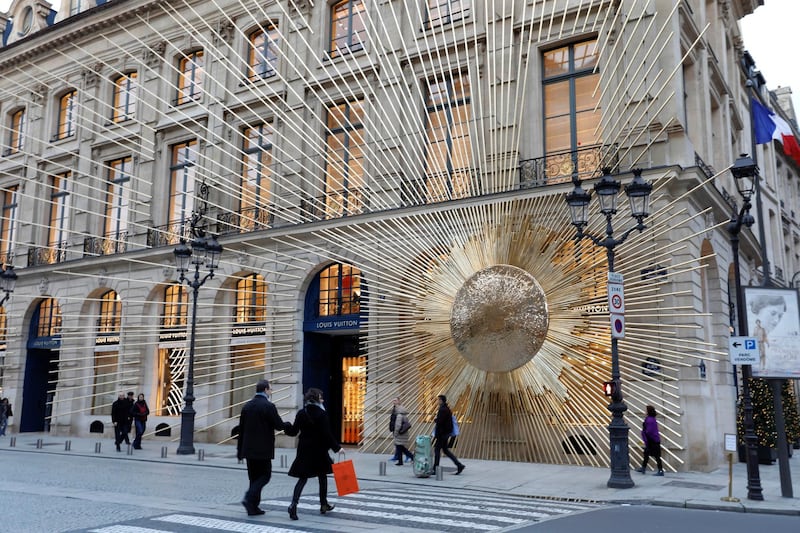A few years ago, Matteo Magnanini received a frantic phone call from the security guards at Mall of the Emirates in the middle of the night, who were worried that a fire had broken out in Harvey Nichols. Al Tayer's vice president of creative services said he had never felt more proud, because the scare proved just how realistic-looking Hot Stuff, the window display that the store's team was putting together – complete with faux burn marks, singed ceilings and blackened, peeling walls – had turned out to be.
"The display was for the hottest trends of that season, and the story was that a Harvey Nichols product is so sizzling hot that it literally burns a hole through anything it touches," Magnanini says. "We treat the window as an artwork, which needs to be interesting, playful and engaging." He adds that often visitors will go from floor to floor to see all the windows to "try and uncover the story we spend months putting together".
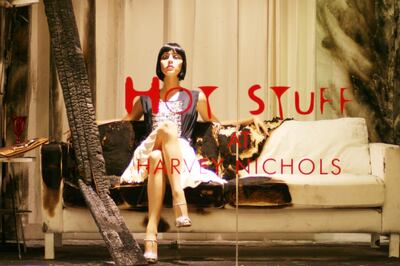
Story is the operative word here. An effective window display is not only about showcasing the products that a store sells, but also about weaving together various elements – from products and props to lights, fixtures and colour – in a creative and cohesive manner, so that it compels visitors to stop and look or, better yet, to enter the store. Themes can be as far-ranging as adventure (rollercoasters in a Louis Vuitton window); literature (J K Rowling's handwritten copy of The Tales of Beedle the Bard at Sotheby's) and nature (from Hermès's oversized plants and toadstools taking over the "world", to live penguins at Woodward & Lothrop).
"In addition to telling a story, another aspect that window displays help with is the positioning of the brand, helping customers to associate with what it stands for, the message it sends out and, of course, its products. Besides showcasing the clothes, shoes and bags we carry, a Harvey Nichols window seeks to inspire people to be unique, stylish, even luxurious – attributes we value as being part of our DNA," says Magnanini.
“The acid test,” admits Jackie King, head of marketing for Sotheby’s Europe, “is, will you look at the window and want to walk inside? Sometimes, it doesn’t have to be the objects themselves, but ideas. So our Collections auction, featuring antique furniture and decorative arts, was promoted through a wall of plates with images of key highlights. This playfully juxtaposed the old and new, as well as reinforcing the accessibility of the items for sale.”
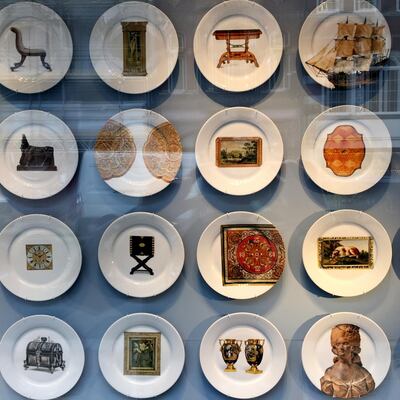
The thought, effort and manpower dedicated to contemporary windows is a far cry from the storefronts of yore, which started off being used as a storage area for surplus goods, according to Herbert Casson, author of Twelve Tips on Window Display, published in the year 1900. This changed after the Industrial Revolution, which led to an increase in the production of mannequins as well as plate glass, or the single-sheet flat glass that are modern-day window panes. This, consequently, resulted in windows that spanned the length of the store, which owners then began to fill with the latest or most interesting merchandise, giving rise to the notion of window shopping. Macy's is even said to have displayed a not-for-sale mechanical songbird in its New York flagship as far back as 1858 – a ploy that's increasingly being used today. In the Christmas of 1899, L Frank Baum (author of The Wizard of Oz) observed in The Show Window magazine that "the recent holiday displays have thoroughly demonstrated the progress of the art of window trimming".
In the early 1900s, Lord & Taylor, America’s oldest luxury department store, became famous for its creative window displays, which made good on Edison’s light bulb. Electricity allowed stores to keep their windows lit at night, drawing sightseers and potential shoppers even after closing hours. In 1902, after air-conditioning was invented, Neiman Marcus wowed visitors with a copper-tubing Christmas tree filled with a refrigerant, which created the illusion of snow-frosted branches, while over in the United Kingdom, American tycoon Harry Gordon Selfridge captured attention with bold art, silk curtains and dramatic publicity stunts at his Selfridges store on Oxford Street.
No mention of creative windows would be complete without referencing Tiffany & Co, which is almost as famed for its illustrious displays as its fine craftsmanship. The grand holiday windows at the 180-year-old jewellery house’s Fifth Avenue boutique have made it on myriad festive must-see lists, and represent a design tradition that the brand has carried forward in its international branches, including those in the UAE. Richard Moore, Tiffany & Co’s vice president of creative visual merchandising, attributes the artistry and inventive storytelling to “resident magician” and former vice president of window display Gene Moore. “Considered one of the leading visual stylists of the 20th century, [Gene] Moore’s imagination between 1955 and 1994 proved boundless. His displays were the talk of the town, enchanting audiences who spread the word of his installations as if they were the latest art gallery opening.”
Indeed, the window dresser often used actual works of art, including pieces by Robert Rauschenberg, Jasper Johns, Alexander Ney and Andy Warhol. “Today, Gene Moore’s creativity is still reflected in Tiffany’s holiday windows across the globe – wonderlands in landscapes where mannequins are the primary props, and products are charmingly displayed as part of the visual narrative,” he adds. “The brand’s signature colour is always showcased, in the form of the Tiffany Blue Box, which adds a particular magic to the windows, in the same way it does when it is received as a gift.”
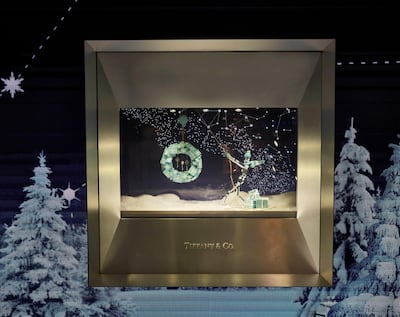
The designs draw inspiration from history, art, pop culture and the jewellery itself. In March, at the Tiffany x Whitney Biennial, the brand collaborated with five sculptors, including Carrie Moyer and Raúl de Nieves, who worked with Tiffany's design and crafts teams to unveil special artist editions. Filmmaker Baz Luhrmann and Oscar-winning costume designer Catherine Martin joined forces to create windows inspired by The Great Gatsby in 2013, while Moore says one of his favourite displays is "an ice carver sculpting Jean Schlumberger's Bird on a Rock design, surrounded by exquisite diamond jewellery from the Victoria collection".
This year, the company partnered with Rubelli and Lobmeyr, world-renowned manufacturers of fabric and glassware, to create exclusive silk threads featuring two million stars of the winter sky’s constellations. Fifteen replicas of the New York Metropolitan Opera’s Starburst chandeliers were also created for Tiffany’s flagship in New York, hand-crafted with 4,500 crystals. “And to add a new level of delight to the Tiffany holiday experience in the Middle East, an interactive LED animation was activated on the façade of The Dubai Mall boutique, enabling our customers to literally join in the celebrations,” says Moore. The region’s boutiques also put up special windows to mark the Holy Month of Ramadan.

Timing plays an important role in effective window design, both in terms of seasons as well as the number of hours dedicated to creating each exhibit. "The holiday season is what we call the Oscars of window displays. It is a time of celebration; there are more people in town; customers have certain expectations and are in a certain frame of mind. All of that calls for extra effort," says Magnanini. "Accordingly, these campaigns take at least eight months to put together, compared to two or three months for a normal concept. Also, we change the displays up to eight times a year, including each time we have a sale."
The process covers the entire gamut of a creative design project, from brainstorming, sketches and mood boards to 3-D renders, sample displays and final execution – which can vary in ways big and small from that first preliminary drawing. "Things often change between conceptualisation and execution; this is a creative process, after all. You may be inspired by things at the last minute, or realise that some key element is too small in size, or the colours need to be upgraded. So it's an ongoing process from the day it's put on paper until the windows are opened to the public. The final touches and tweaks are added until the very last day," explains Magnanini.
“The creative idea evolves countless times before the final concept is agreed upon,” confirms Moore. In addition to being a huge team effort, you have to seek out partners who really understand the craft and the high level of detail. The team begins the ideation process a year in advance, and it takes an additional four months to complete one Tiffany & Co window from start to finish.”
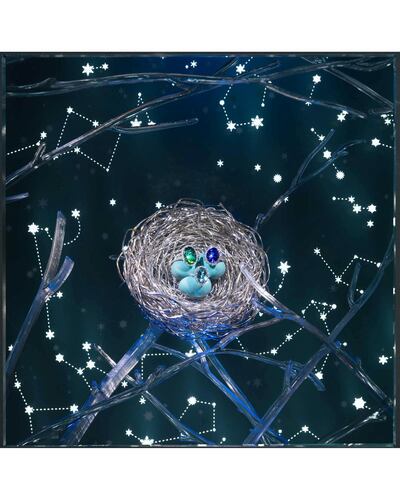
As with most design-led projects, visual merchandisers are constantly evolving and improvising. Yet, there are certain no-nos when it comes to an effective display, say the experts. For Sotheby's King, a window should not be two-dimensional or too literal, but rather intriguing enough for people to want to walk in, while Magnaniniis cautious about treading the line between being creative and avant-garde, while displaying cultural sensitivity, especially in this region.
“A big no-no for us would be displaying anything that’s offensive to local culture, or that’s not right for this market,” he says. “Another thing we refrain from doing is using materials that cheapen the story. For example, we never use cardboard signage. The whole point of the window is to showcase sophistication and craftsmanship – the luxury tag is not only relevant for our products, it also trickles down to the message we put out, from the tools and props to the fabrics and even the mannequins we use. After all, you rarely get a second chance at making a first impression.”
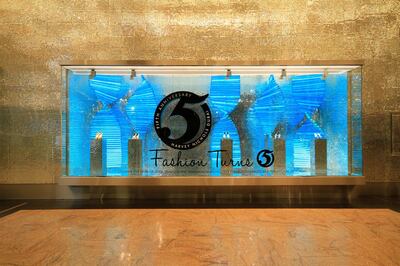
_______________
Read more
[ Expensive toys: a doll’s house that’s worth more than 100,000 dirhams ]
[ Tiffany boutiques in the UAE put up Arabian-themed windows for Ramadan ]
[ Step into customisable shoes as bespoke British brand Swear opens in UAE ]
_______________
